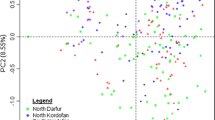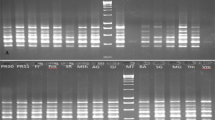Abstract
A collection of 133 apricot cultivars and three related species originating from different geographical regions were studied with 10 polymorphic microsatellite markers developed in apricot. Altogether, 133 alleles were identified in the set of accessions, with an average of 13.30 alleles per locus. Out of them, 32 alleles occurred only once in the investigated samples, especially in apricots originating from different eco-geographic groups or in different species. The observed heterozygosity for individual loci ranged from 0.8636 to 0.3182, with an average of 0.6281. An unweighted pair group method with arithmetic mean dendrogram based on Nei's genetic distance grouped the accessions according to their eco-geographical origin and/or their pedigree information. Central Asian cultivars have a distinct position on the dendrogram, which supports the assumption that most cultivars have an Asian ancestor. Most East European cultivars analysed cluster together, and the data even revealed a few synonyms. Results show that American cultivars have not only European germ plasm in their pedigree, but they have also been enriched with germ plasm of Asian origin. The implications of these data for the use of simple sequence repeat (SSR) markers as a tool for fingerprinting cultivars in breeders' rights protection and apricot breeding are discussed. In this paper, we demonstrate for the first time the variability of apricot SSRs in a large collection of apricot cultivars and closely related species.


Similar content being viewed by others
References
Audergon JM (1995) Variety and breeding. Acta Hortic 384:35–45
Badenes ML, Asíns MJ, Carbonell EA, Llácer G (1996) Genetic diversity in apricot (Prunus armeniaca L.) attending to Plum Pox Virus resistance. Plant Breed 115:120–133
Badenes ML, Martínez-Calvo J, Llácer G (1998) Analysis of apricot germplasm from the European eco-geographical group. Euphytica 102:93–99
Bassi D, Bellini D, Guerriero R, Monastra F, Pennone F (1995) Apricot breeding in Italy. Acta Hortic 384:47–54
Brozik S, Kállay T (2000) Csonthejas gyümölcsfajtak. Agrarmarketing Centrum, Budapest, pp 127–154
Ciofi C, Funk SM, Coote T, Cheesman D, Hammond RL, Saccheri IJ, Bruford MW (1998) In: Karp A, Isaac PG, Ingram DS (eds) Molecular tools for screening biodiversity. Chapman and Hall, London, pp 413–417
De Vicente MC, Truco MJ, Egea J, Burgos L, Arús P (1998) RFLP variability in apricot (Prunus armeniaca L.). Plant Breed 117:153–158
Egea J, Burgos L, Martinez-Gomez P, Dicenta F (1999) Apricot breeding for sharka resistance at CEBAS-CSIC, Murcia (Spain). Acta Hortic 488:153–157
FAOSTAT (2004) Agriculture database. Web site: http://faostat.fao.org/faostat/collections?version=ext&hasbulk=0&subset=agriculture
Faust M, Surányi D, Nyujtö F (1998) Origin and dissemination of apricot. Hortic Rev 22:225–266
Fischer M (2003) Farbatlas Obstsorten. Verlag Eugen Ulmer, Stuttgart, Germany, pp 195–201
Fossati T, Grassi F, Sala F, Castiglione S (2003) Molecular analysis of natural populations of Populus nigra L. intermingled with cultivated hybrids. Mol Ecol 12, 2033–2043
Geuna F, Toschi M, Bassi D (2003) The use of AFLP markers for cultivar identification in apricot. Plant Breed 122:526–531
Gogorcena Y, Parfitt DE (1994) Evaluation of RAPD marker consistency for detection of polymorphism in apricot. Sci Hortic 59:163–167
Gurrieri F, Audergon JM, Albagnac G, Reich M (2001) Soluble sugars and carboxylic acids in ripe apricot fruit as parameters for distinguishing different cultivars. Euphytica 117:183–189
Hagen S, Khadari B, Lambert P, Audergon JM (2002) Genetic diversity in apricot revealed by AFLP markers: species and cultivar comparisons. Theor Appl Genet 105:298–305
Hagen S, Chaib J, Fady B, Decroocq V, Bouchet P, Lambert P, Audergon JM (2004) Genomic and cDNA microsatellites from apricot (Prunus armeniaca L.). Mol Ecol Notes 4:742–745
Hartl DL, Clark AG (1997) Principles of population genetics, 2nd edn. Sinauer, Sunderland
Hormaza JI (2001) Identification of apricot (Prunus armeniaca L.) genotypes using microsatellite and RAPD markers. Acta Hortic 546:209–215
Hormaza JI (2002) Molecular characterization and similarity relationships among apricot (Prunus armeniaca L.) genotypes using simple sequence repeats. Theor Appl Genet 104:321–328
Guerriero R, Watkins R (eds) (1984) Revised descriptor list for apricot (Prunus armeniaca). IBPGR Secretariat, Rome, CEC Secretariat, Brüssels
Karp A, Seberg O, Buiatti M (1996) Molecular techniques in the assessment of botanical diversity. Ann Bot 78:143–149
Kostina KF (1969) The use of varietal resources of apricots for breeding. Trud Nikit Bot Sada 40:45–63
Levene H (1949) On a matching problem in genetics. Ann Math Stat 20:91–94
Lichou J (1998) Abricot. Ctifl, Paris, France, pp 186–248
Lichou J, Jay M, Vaysse P, Lespinasse N (2003) Recognizing apricot varieties. Ctifl, Paris, France, pp 32–89
Lopes MS, Sefc KM, Laimer M, da Câmara Machado A (2002) Identification of microsatellite loci in apricot. Mol Ecol Notes 2:24–26
Löschnig HJ, Passecker F (1954) Die Marille (Aprikose) und ihre Kultur. Östereichischer Agrarverlag Wien, Austria
Messina R, Lain O, Marrazzo MT, Cipriani G, Testolin R (2004) New set of microsatellite loci isolated in apricot. Mol Ecol Notes 4:432–434
Mehlenbacher SA, Cociu V, Hough F (1991) Apricot (Prunus). In: Moore JN, Ballington RJ (eds) Genetic resource of temperate fruit and nut crops. ISHS, Wageningen, pp 65–107
Morgante M, Olivieri AM (1993) PCR-amplified microsatellites as markers in plant genetics. Plant J 3:175–182
Nei M (1972) Genetic distance between populations. Am Nat 106:283–292
Nei M (1973) Analysis of gene diversity in subdivided populations. Proc Natl Acad Sci U S A 70:3321–3323
Nei M (1978) Estimation of average heterozygosity and genetic distance from a small number of individuals. Genetics 89:583–590
OECD (2002) Consensus document on the biology of Prunus sp. (stone fruits): series on harmonization of regulatory oversights in biotechnology nr. 24. http://www.olis.oecd.org/olis/2002doc.nsf/LinkTo/env-jm-mono
Page RD (1996) TreeView: an application to display phylogenetic trees on personal computers. Comput Appl Biosci 12:357–358
Powell W, Machray GC, Provan J (1996) Polymorphism revealed by simple sequence repeats. Trends Plant Sci 7:215–222
Rehder I (1940) Manual of cultivated trees and shrubs hardy in North American. MacMillan, New York
Romero C, Pedryc A, Munoz V, Llacer G, Badenes ML (2003) Genetic diversity of different apricot geographical groups determined by SSR markers. Genome 46:244–252
Ruthner S, Bisztray DG, Deak T, Laimer M, Pedryc A (2003) Characterization of apricot varieties with different origin using molecular markers. 4th international conference of Ph.D. students, University of Miskolc, Hungary
Steinkellner H, Lexer C, Turetschek E, Glössl J (1997) Conservation of (GA)n microsatellite loci between Quercus species. Mol Ecol 6:1189–1194
Strada GD, Pennone F, Fideghelli C, Monastra F, Cobianchi D (1989) Monografia di cultivar di albicocco. Istituto Sperimentale per la Frutticoltura, Roma
Takeda T, Shimada T, Nomura K, Ozaki T, Haji T, Yamaguchi M, Yoshida M (1998) Classification of apricot varieties by RAPD analysis. J Japan Soc Hort Sci 67:21–27
Tautz D, Schlötterer C (1994) Simple sequences. Curr Opin Genet Dev 4:832–837
White KD (1970) Roman farming. Cornell University Press, Ithaca
Zhebentyayeva TN, Sivolap YM (2000) Genetic diversity of apricot determined by isoenzyyme and RAPD analyses. Acta Hortic 538:525–529
Zhebentyayeva TN, Reighard GL, Gorina VM, Abbott AG (2003) Simple sequences repeat (SSR) analysis for assessment of genetic variability in apricot germplasm. Theor Appl Genet 106:435–444
Zohary D, Spiegel Roy P (1975) Beginning of fruit growing in the Old World. Science 187:319–327
Zohary D, Hopf M (1994) Domestication of plants in the Old World, 2nd edn. Clarendon, Oxford, pp 134–180
Yeh FC, Boyle TJB (1997) Population genetic analysis of co-dominant and dominant markers and quantitative traits. Belg J Bot 129:156–159
Acknowledgements
Drs. A. Martinelli (CIV, Ferrara, Italy), M. Fliri (South Tyrol) and R. Zelger (Laimburg, South Tyrol) are kindly acknowledged for providing material of CIV breeding lines, seedlings of apricots from Pakistan and Vinschger Marille, respectively. The authors thank the ZAG, BOKU, Vienna, for the opportunity to use the Capillary Sequencer 3100. This work was supported financially by the projects “Pannonia” of the BMBWK and “Charakterisierung transgener Obstbäume und Untersuchungen direkter und indirekter biologischer Wechselwirkungen” of the BMBWK and the BMLFUW.
Author information
Authors and Affiliations
Corresponding author
Rights and permissions
About this article
Cite this article
Maghuly, F., Fernandez, E.B., Ruthner, S. et al. Microsatellite variability in apricots (Prunus armeniaca L.) reflects their geographic origin and breeding history. Tree Genetics & Genomes 1, 151–165 (2005). https://doi.org/10.1007/s11295-005-0018-9
Received:
Revised:
Accepted:
Published:
Issue Date:
DOI: https://doi.org/10.1007/s11295-005-0018-9




